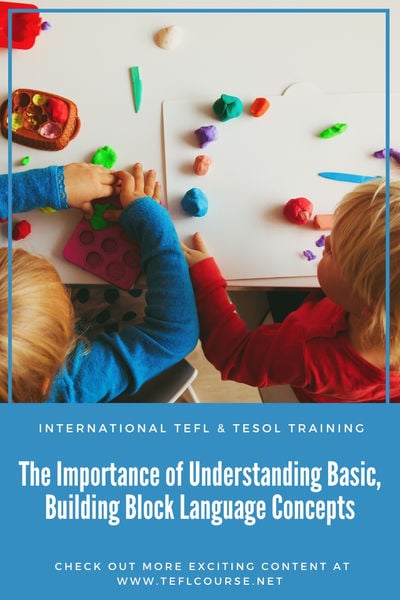Teaching a Multilingual Classroom: The Importance of Understanding Basic, Building Block Language Concepts

Teachers of English as a Foreign Language are often native English speakers. As such, there are many language concepts, especially grammatical ones, that are subconsciously understood due to having learned them in early childhood. One of the most important parts of TEFL training is relearning these concepts from the perspective of one who does not speak English. This can often be one of the most revelatory parts of the process as it can be disconcerting to uncover seemingly unfamiliar concepts and rules to language one already know perfectly. In a monolingual class, this can sometimes be remedied by relating vocabulary and concepts to the students' native language. In a multilingual classroom, a classroom whose students do not all share the same native language, this frame of reference does not exist and teachers must understand and be able to easily teach concepts from a very basic, shared understanding.
Table of Contents
Listening and Speaking activities
Do you want to teach English abroad? Take a TEFL course!
This post was written by our TEFL certification graduate Wayne F. Please note that this blog post might not necessarily represent the beliefs or opinions of ITTT.
Grammar
Students of English need to initially be taught grammatical concepts in the simplest way possible to create a foundation that a teacher can then build upon later in the class. Counterintuitively, it can often be harder to teach grammar in the simplest way possible than it is to teach it at a higher level. This is because many of the grammar rules that native English speakers know and follow are incorporated through verbal exposure to the language at a very young age rather than through drilling in grammatical lessons. Yes, it is reinforced later in school but we learn a lot of our basic English grammar long before we set foot in an English classroom in primary school. For students of English as a Foreign Language, these concepts are not part of their subconscious and need to be taught from scratch.
One of the most important of these grammatical concepts that require building-block style instruction is tense: past, present, and future. EFL teachers must be able to teach how to use the simple, perfect, continuous forms of these tenses, among others, while also teaching their usages and how to distinguish between situations in which different forms are needed. For example, if a teacher needed to teach a class when to use the present simple tense or the present continuous tense, they are not able to relate it to the students' native language as they don't share one. The teacher must be able to explain, in simple English, that the present simple tense is to be used for routine, permanent situations, directions and instructions, present stories, etc. while the present continuous tense is used to talk about actions in progress, frequent actions, to describe developing situations, etc. This can often be accomplished with exercises and games as well as through the use of visual aids and elicitation activities.

Also Read: How do I get a job teaching English in China?
English only
It is important for teachers of multilingual classes to always speak English and never revert to any of the students' native languages as it will not be useful or fair to the other students who don't speak that language. This can sometimes be difficult when teaching vocabulary that may look more familiar to students whose native languages are Romance or Germanic languages and share a high number of cognates with English, but much less familiar to students whose native languages don't share as much or any similar vocab, or even the same alphabet. Subsequently, when teaching vocabulary, it's important to use varied and interesting activities to help everyone have a chance to learn the content fully and holistically. Using activities like gap-fill exercises and example sentence exercises may unfairly benefit students whose native languages allow them to use context more easily so it's important to mix in other activities like matching with pictures and pronunciation drilling.
Also Read: How much can I earn teaching English in China?
Listening and Speaking activities
With a multilingual group of students, it can also be helpful to use a lot of listening and speaking activities, especially at the beginning of a course so that all students are on a more level playing field regardless of the native language. Romance and Germanic languages can sometimes be quite similar to English in writing but not so much orally. Exercises that feature listening to audio materials allow all students to understand and learn the language on a more even basis. This can help the students to feel equal at the beginning of a course. It can also prompt response based exercise in which a teacher can use choral exercises to get all the students speaking and responding similarly.
Do you want to teach English abroad? Take a TEFL course!
There are many extra considerations to be made when teaching a multilingual classroom taking into account the difference in reference knowledge of each student. A good EFL teacher will use these techniques and strategies to make sure that they are teaching concepts from a very basic, building-blocks level of understanding and that their students are benefitting equally from the lessons.
Apply now & get certified to teach english abroad!
Speak with an ITTT advisor today to put together your personal plan for teaching English abroad.
Send us an email or call us toll-free at 1-800-490-0531 to speak with an ITTT advisor today.
Related Articles:
- The How-To Guide to Prepare for Your Teaching Job Abroad
- 3 Steps for Dealing with a Student with Challenging Behavior
- Getting Student Placement Right - The Best Desk Arrangements for EFL Students
- The 3 Most Important Parts of Classroom Management for ESL Teachers
- 5 Keywords to Increase Your Confidence in the Classroom as a Teacher
- The 5 Most Common Types of EFL Students and How to Deal with Them




